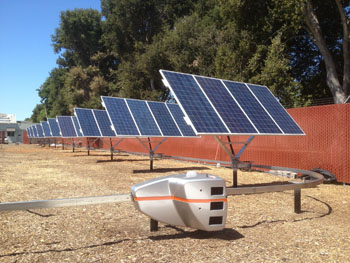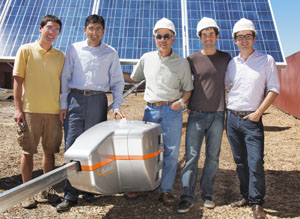 MENLO PARK, Calif. — Just how high-tech is the Menlo Park, Calif.-based company QBotix? To answer that question, let me introduce the QBotix Tracking System (QTS).
MENLO PARK, Calif. — Just how high-tech is the Menlo Park, Calif.-based company QBotix? To answer that question, let me introduce the QBotix Tracking System (QTS).
QTS is a comprehensive dual-axis tracking system that employs rugged, intelligent and mobile robots to dynamically operate solar power plants and maximize energy output. The robot works on a site with 20 solar panels and makes its rounds at each array, pops its arm out and mechanically adjusts the angle of the photovoltaic panels to track the sun throughout the day and the seasons to maximize electricity production.
“Robots have proven themselves in extreme and diverse environments from the surface of Mars to battlefields and ocean depths,” said Wasiq Bokhari, chief executive officer and founder of QBotix in a statement. “We’re now deploying the innovations developed in robotics over the last several decades to manage solar power plants.”
The company has raised $7.5 million in funding, including $6.5 million from high-profile investment capital firms like NEA and Firelake Capital. Other investors include Siemens Venture Capital and DFJ JAIC.
The cost savings of the solar robots are actually greater than many other solar tracking systems. By utilizing the robot at the solar farm, it will eliminate individual trackers. The robot itself will replace hundreds of expensive individual motors and controllers found on conventional tracking systems. QTS costs as much as existing single axis systems but generates up to 15 percent more energy — in comparison, the system will generate up to 40 percent more energy than fixed mount systems.
The robots travel on a track and adjust each solar mounting system to optimally face the sun. Each robot replaces hundreds of individual motors and controllers found on conventional tracking systems, according to QBotix.
 “Our main focus is to deliver a compelling combination of high performance, reliability, competitive cost and unprecedented intelligence to our customers,” he said. “Regardless of the choice of solar panels, inverters, foundations or other system components, the use of QTS will dramatically lower Levelized Energy Cost (LCOE) compared to all existing mounting or tracking systems.”
“Our main focus is to deliver a compelling combination of high performance, reliability, competitive cost and unprecedented intelligence to our customers,” he said. “Regardless of the choice of solar panels, inverters, foundations or other system components, the use of QTS will dramatically lower Levelized Energy Cost (LCOE) compared to all existing mounting or tracking systems.”
Each robot can adjust 200 solar panel arrays in 40 minutes and consumes about 30 cents of electricity a day, according Bokhari.
There are many benefits to using the robotic tracking system, including site location for installation. The system does not require land to be level or graded for solar installation, therefore developers do not have to bury wiring — as it runs in a conduit alongside the QBotix monorail. Other benefits include low maintenance and operations costs, compatibility with all solar panels and mounting foundations, and fast installation.
“We can install on lands where traditional tracking systems cannot be installed,” said Bokhari in a statement. “You could install on the side of a hill and the tracks can follow the contour of the hill.”
Project developers will appreciate the new technology as well, as QTS has a better return on investment, greater system reliability and performance for operators and owners, and solar energy that competes in price globally with conventional grid power for utilities and consumers.
“The capabilities of the QBotix Tracking System represent a huge leap forward in balance of systems technology. This is one of the biggest innovations of the solar industry in the last decade,” said Forest Baskett, general partner at NEA and a QBotix board member in a statement.

